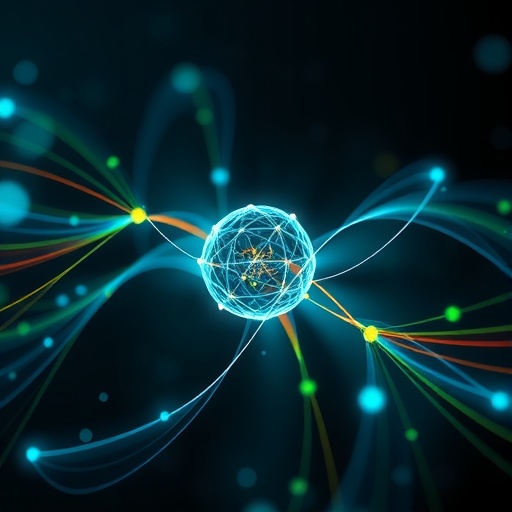In a groundbreaking advancement at the intersection of physics and artificial intelligence, researchers at the Institute of Cosmos Sciences of the University of Barcelona (ICCUB) have unveiled a novel machine learning framework that significantly elevates the capabilities of solving complex differential equations—especially those that challenge traditional computational methods. This pioneering study, spearheaded by doctoral candidates Pedro Tarancón-Álvarez and Pablo Tejerina-Pérez, presents a sophisticated integration of physics-informed neural networks (PINNs) enhanced with innovative training strategies and regularization techniques. The work, published in the prestigious journal Communications Physics, represents a turning point for computational physics, promising new horizons in deciphering some of the most intricate problems in science.
Differential equations form the backbone of modern physics, encoding the fundamental laws governing dynamic systems from fluid flows to the curvature of spacetime. Among these, stiff differential equations—characterized by vastly different time scales or sensitive parameters—have notoriously resisted effective numerical treatment. Their stiffness results in computational instability and inefficiency that conventional solvers fail to overcome, particularly when these equations arise in inverse problems where the goal is to deduce unknown physical parameters or laws from empirical data. The ICCUB team’s breakthrough lies precisely in addressing these limitations by marrying machine learning’s flexibility with the rigorous constraints of physical law.
Physics-informed neural networks have emerged recently as promising tools capable of embedding physical laws into the architecture of artificial intelligence. Unlike classical neural networks that rely solely on data, PINNs incorporate differential equations directly into the loss function guiding training, ensuring solutions adhere to physical principles. This innovative approach enables PINNs not only to predict system behavior but also to infer unknown parameters by effectively solving inverse problems. However, their application to stiff equations remains complicated by difficulties in training stability and the risk of overfitting specific problem instances.
To overcome these hurdles, the ICCUB researchers introduced a twofold strategy advancing the capabilities of PINNs. The first innovation, Multi-Head (MH) training, allows the neural network to simultaneously learn a generalized solution space applicable to an entire family of differential equations rather than being confined to a single instance. This broader learning scope significantly enhances the model’s adaptability, enabling it to interpolate between different physical scenarios and maintain robustness when confronted with new challenges.
Complementing this, the team devised a method termed Unimodular Regularization (UR), inspired by mathematical concepts from differential geometry and general relativity. UR stabilizes the neural network’s learning trajectory by enforcing geometric constraints on the solution space, preventing pathological behaviors and improving generalization. Essentially, UR acts as a refined regulator that guides the PINN towards physically consistent and stable solutions, even under the most demanding computational conditions.
The efficacy of these combined techniques was demonstrated across three increasingly complex and physically meaningful systems. Beginning with the flame equation, which models reactive flows in combustion processes, and progressing to the Van der Pol oscillator, a classical nonlinear system exhibiting limit cycles and stiffness, the approach consistently produced accurate and stable solutions. Most notably, the framework tackled the Einstein Field Equations within a holographic setup—an audacious test since these equations underpin general relativity and are famously challenging to solve or invert. Here, the researchers succeeded in recovering unknown physical functions from synthetic observational data, achieving what was previously considered near-impossible.
Pedro Tarancón-Álvarez highlights the transformative potential of these developments, noting the recent surge in PINN popularity owes much to improvements in training efficiency and network design. He emphasizes the capability of PINNs to address inverse problems efficiently, offering a paradigm shift beyond traditional numerical solvers that often rely on brute-force methods or simplifying approximations.
Pablo Tejerina-Pérez elaborates on the complexity of inverse problems, comparing them to puzzles missing critical pieces that define unique and physically meaningful solutions. Traditional approaches struggle with guessing or approximating these pieces, frequently leading to ambiguous or incorrect outcomes. In contrast, the enhanced PINN system intelligently infers these missing elements by seamlessly integrating physical law constraints and advanced learning schemes, thus navigating complex solution landscapes with unprecedented precision.
This research not only propels the science of computational physics forward but also opens avenues for practical applications across diverse domains such as climate modeling, materials science, and astrophysics, where stiff differential equations abound and complex inverse problems are routine. By weaving deep learning with fundamental physics and sophisticated mathematical frameworks, the ICCUB team’s approach exemplifies the growing synergy between AI and traditional scientific disciplines.
The study was conducted in collaboration with esteemed colleagues Raúl Jiménez (ICREA-ICCUB) and Pavlos Protopapas from Harvard University. Funding support came from the Spanish Ministry of Science and Innovation and the Maria de Maeztu Excellence Programme, underscoring the high national and international recognition of the impact and potential of this research.
As machine learning continues to intertwine more deeply with fundamental science, frameworks such as this may become indispensable tools for scientists, augmenting human intuition and computational power alike. The enhanced PINNs forged by the Barcelona group provide a promising blueprint for future explorations into the unknown landscapes of physics, potentially accelerating discoveries and fostering deeper understanding of the universe’s most intricate phenomena.
Subject of Research: Not applicable
Article Title: Efficient PINNs via multi-head unimodular regularization of the solutions space
News Publication Date: 15-Aug-2025
Web References:
https://www.nature.com/articles/s42005-025-02248-1
http://dx.doi.org/10.1038/s42005-025-02248-1
Image Credits: Communications Physics
Keywords
/Physical sciences/ Physics
Tags: advanced AI methodscomplex physics equationscomputational physics advancementempirical data analysisinnovative training strategiesinverse problems in physicsmachine learning frameworkphysics-informed neural networksregularization techniquessolving differential equationsstiff differential equationsUniversity of Barcelona research





